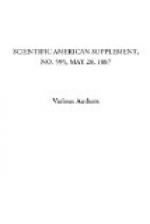In practice, the punka should just clear his head when standing, and the weighting of the curtain should be of some yielding material, so as not to damage any person who might stand in its course.
We shall now proceed to examine several forms of punka, all made to the same size, and, for purposes of comparison, we shall drive them all at the same speed. And in order that their effects may be visible to you, I have prepared an indicator which resembles more than anything else the keyboard of a piano. It consists of a series of balanced levers with blades or keys attached, forming a keyboard four feet long. The levers, each three feet long, are delicately hung on fine brass centers, and each lever is counterbalanced by a weight hung in a vessel of water, which acts as a hydraulic brake, and checks any spasmodic movement in the apparatus.
On the end of each blade is fixed a disk of white Bristol board four inches in diameter, forming a row which faces the audience.
This apparatus is so sensitive that a slight change in the humidity of the atmosphere is sufficient to throw it out of balance.
The power required to drive a punka is nearly all due to the resistance of the air; that part due to the force of gravity, and the friction of the suspending joints, is scarcely worth counting. We may readily observe the effect of the resistance of the air by swinging two pendulums of equal length and having each a large cardboard disk attached. One of the disks shall present its edge to the line of movement, and the other its face.
Exp. 1.—They are now swinging, and being both of the same gravity length, they should swing together and for an equal length of time. This they would do in a vacuum, but you have already observed that one of them is lagging, and will evidently soon come to a standstill. It is the one facing the air.
If punkas were pulled from both sides, they might be made very much lighter than they are at present, but for the sake of simplicity a single pull is preferred. They must, therefore, be made of such a weight that they will swing nearly as far on the opposite side as they are pulled on the near side; any greater weight is useless and only serves to wear out the suspending cords, which, by the way, are nearly always too numerous and too thick for their purpose.
Exp. 2.—Here is a panel punka which we shall try to use without the customary swing bar. It is of calico stretched on a light wooden frame, and you will be able to judge if it swings equally on each side of the post which supports it. The irregularity of its movement shows that it is too light, so we shall add, by way of swing bar, a bar of round iron one and a quarter inch thick.
Exp. 3.—It is now swinging regularly, and experiments have already proved that the swing bar should not be lighter than this one, which weighs four and a sixth lb. per foot of length. Iron is the best material for this purpose, as it offers the smallest surface to the resistance of the air. The length of the suspending cords is usually a matter of accident in the construction of a punka, but a little attention to the subject will soon convince us that it is one of the most important considerations.




